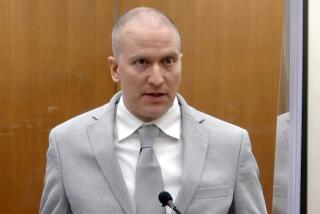Inmate’s Death Sparks Charges of a Cover-Up
- Share via
OKLAHOMA CITY — Two years ago, Kenneth Michael Trentadue was hauled into a newly built federal prison said to be suicide-proof. Just over two days later, he was found dead in his cell.
Authorities say he hanged himself with a bedsheet on Aug. 21, 1995. His family and a state investigator say evidence--bruises on the soles of his feet, traces of blood covering the cell--indicate he was killed.
“There’s injuries that can’t be explained and aren’t reasonably explained as self-inflicted,” said Kevin Rowland, chief investigator for the state medical examiner’s office.
Armed with photos showing he was bruised and battered from head to toe, Trentadue’s widow, Carmen, and family believe the 44-year-old man was beaten to death by guards.
Family members believe Trentadue--strong and stocky, with a 19-inch neck--fought back.
“He wouldn’t pick a fight, but he wouldn’t back down from anybody no matter how many there were,” said his brother, Jesse Trentadue, a Salt Lake City attorney.
Trentadue’s family has sued the U.S. Bureau of Prisons, the Justice Department and the FBI, accusing officials of trying to hide the circumstances of Trentadue’s death and protect his killers. They are seeking unspecified damages.
Jesse Trentadue accuses jail officials of covering up his brother’s slaying in a number of ways, among them: sanitizing his brother’s cell on the day he died, destroying important evidence; trying to stop a state medical examiner from examining the cell; and claiming that surveillance cameras malfunctioned at the moment his brother died, leaving no photographic evidence.
Amid mounting criticism, a federal grand jury began looking into Trentadue’s death 11 months ago. The grand jury has taken no action, prompting complaints from family members that the Justice Department was interfering to impede the investigation.
Justice Department spokeswoman Lee Douglas said the investigation was pending and declined to comment further.
The Bureau of Prisons has said the death of Trentadue, a convicted bank robber who was awaiting hearings on an alleged parole violation, was “suicide by asphyxiation” and that his many other injuries were self-inflicted.
Trentadue died during a 20-minute period between bed checks by hanging himself from an air vent, the bureau said.
It was the first reported suicide at the Federal Transfer Center, which opened four months before Trentadue’s death.
The medical examiner who performed the autopsy, Dr. Fred Jordan, said that when blood-tracing compounds were applied to the floor and walls of Trentadue’s cell, it “lit up like a Christmas tree.”
Trentadue had been struck three times on the head, two of which split his scalp open. And, Rowland said, bedsheets don’t cause the kind of gouging wound that investigators found on Trentadue’s neck.
“They want us to believe that all of this was self-inflicted and it all occurred in under 20 minutes without anybody knowing it was going on,” Rowland said. “Most hangings don’t have bruises on the soles of their feet and their knuckles.”
The U.S. Citizens Human Rights Commission, a Salt Lake City-based group, has offered a $10,000 reward for information that will help solve Trentadue’s death.
“They have something to hide,” said former Rep. George Hansen (R-Idaho), national chairman of the commission. “What it is is the question.”
More to Read
Sign up for Essential California
The most important California stories and recommendations in your inbox every morning.
You may occasionally receive promotional content from the Los Angeles Times.










